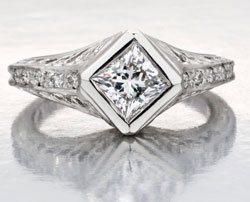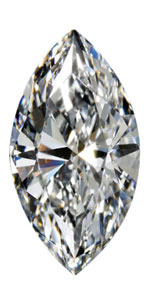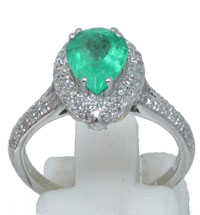Point Protection
 Diamond is the hardest gem. Only another diamond can cut or scratch it. In fact, diamond has a reputation of being "forever."
Diamond is the hardest gem. Only another diamond can cut or scratch it. In fact, diamond has a reputation of being "forever."
Yet insurers often pay claims on chipped diamonds. And some of those chips could have been avoided.
Chipping
How well a gem survives in jewelry depends on both its hardness and its toughness. Diamond is the hardest gemstone known, so it is safe from abrasion. But its toughness rating is only fair to good. This means diamond's ability to withstand breakage from an impact is only middling. A blow at the wrong angle can cause that very hard diamond to chip.
Oddly enough, both the shape of the diamond and how it is set in jewelry can work to minimize the chances of chipping.
Shape
It's estimated that half the diamonds sold today are round brilliant. This classic cut not only has the most fire and brilliance, but it's also a winner because round is a strong shape. It has no protruding corners or sharp angles that could easily chip off under impact.
 Round |
 Marquis |
 Pear |
 Princess |
Stones cut in some other popular shapes, such as marquis, pear or princess, are more vulnerable. Even diamond can easily chip at a point that is exposed.
Setting
It's up to the jeweler to design a setting that not only enhances the gem but protects it.
The two end points of the marquis cut diamond, shown above, are vulnerable. A direct hit on those of the points could easily chip the stone. The center picture shows a marquis cut diamond with unprotected points that could be easily damaged. The jeweler who set the ring show at the right used V-prongs to protect the diamond's points.
Here are two settings of a pear-shaped gem. In the ring at left, the emerald's point is exposed and could easily be chipped. Damage is especially likely because emeralds are rather fragile. In the ring at right, the designer set a pear-shaped diamond in a bezel that shows off the gem's shape while completely protecting the point and the girdle of the stone. A similar all-around protection is given to the princess cut stone shown at the top of the page.
Having a protective setting is less important for earrings or pendants than for rings, as rings are likely to be subject to impact. If you're thinking broken fingers, don't! Even a comparatively slight knock at just the right angle can chip an exposed point of a gem.
So, what does all this mean to insurers? Do underwriters and adjusters have to know all about marquises and bezels and prongs?
Pictures
This is one reason to ask that a picture accompany the appraisal.
We know that a picture can show much more detail that could ever be described in language on an appraisal. In the past we've discussed the important role of a photo in identifying jewelry and in pricing a replacement after a total loss.
A picture can also reveal if the stone is not well protected in its setting. If the stone in a ring has exposed points, which are likely to chip under impact, this is damage waiting to happen. It may even be considered inherent vice.
An underwriter who sees such vulnerable points can decide whether or not to take the risk. For a half-carat marquis valued at $4,000, it may not matter. For a 5-carat marquis worth $100,000, it's an important consideration. The underwriter may want to add an endorsement to the policy that excludes breakage altogether; or he may simply want to decline coverage.
There is a lot of poorly crafted, poorly mounted, highly damageable jewelry out there. In an ideal world, the appraiser would note such potential for damage—just as he would note a loose stone in danger of falling out. But most appraisals do not meet this standard. It's up to the insurer to take advantage of all possible clues in spotting potential risks.
FOR AGENTS & UNDERWRITERS
An appraisal or lab report should identify the shape of the stone, and that shape is a clue as to the potential for easy damage because of improper mounting. A look at popular gem shapes will help you identify the terms gemologists use for shapes.
Note: Some appraisals and other documents misleadingly list the shape of a gem as its cut. (Cut is a completely different and much more complex issue, not directly relevant to our discussion here of shapes. See Cut as one of the 4Cs for an explanation of cut.)
A photo should be included with the appraisal for any high-value jewelry. A photo can:
- Show poor settings that could lead to costly claims
- Identify the jewelry and prove it exists
- Show how jewelry looked before a damage claim
- Show detail too complex for words to describe
- Help in pricing a replacement
- Help prevent fraud
Review Every picture tells a story and How photos cut fraud and help the insured.
It is best to have a detailed JISO 78/79 (formerly ACORD 78/79) appraisal from a competent and experienced jeweler/appraiser who has a GG, FGA+ or equivalent degree, and preferably is also a Certified Insurance Appraiser™ (CIA).
FOR ADJUSTERS
In a gem of any shape, poor cut proportions can produce places vulnerable to damage, such as a too-thin girdle. A detailed appraisal, such as JISO 78/79, will give all cut proportions. From such an appraisal, an experienced jeweler can determine whether cut proportions were so poor as to constitute inherent vice.
On a damage claim for a high-priced diamond, always have the piece examined by a qualified gemologist, such as a Certified Insurance Appraiser™, to determine whether the diamond was properly set, whether damage was due to inherent vice, and to be sure the gem's qualities are as stated in the appraisal.
If you have any suspicion that damage may be due to inherent vice, it may be worthwhile consulting a jewelry insurance expert.
Make use of the picture when pricing a replacement. It often reveals details that are not mentioned on the appraisal.
For damage claims, a photo may show that damage can be repaired at far less expense than a total-loss payout.
©2000-2025, JCRS Inland Marine Solutions, Inc. All Rights Reserved. www.jcrs.com






